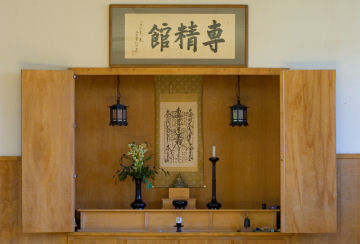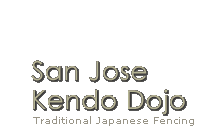San Jose Kendo Dojo
Etiquette and FAQ.
Are you interested in joining because you just saw a movie?
You say Black Belt, we say
Sho Dan.
Why don't you wear colored belts in kendo?
How long will it take to get my Black Belt?
Rei-ho....or, why all the bowing?
Visiting a Dojo for the first time
I just saw a movie and.........
If you have recently seen a movie which has created an interest in
Kendo and the discipline that is inherent in the practice and
application of kendo, we welcome you to come watch a practice to see if
this might be the place for you.
You say Black Belt, we say Sho Dan.
Contrary to popular myth, "Black belt" is not a rank
in the martial arts. It was all started around 1882 by a wealthy
Japanese commoner, Dr. Kano Jigoro of the Kodokan.
Dr. Kano developed a system for awarding proficiency ranks to his Judo
students. The system was based on kyu, which is translated
as "class" or "ungraded" ranks and dan, pronounced "don"
translated as "having rank" So, the ranks are kyu and dan.
The insignia worn by the kyu ranks are the different colored belts
you see in many schools. The insignia worn by the dan ranks are black
belts. Just as a master sergeant wears many chevrons on his shoulder as
the insignia of a Master sergeants rank, he would not be called a
chevron, and a General would not be called a Star. The same holds true
in the martial arts,such that a person should not reffer to their or
anothers rank as being a "Black Belt" as this is only an indication of
the rank, not the rank itself. Got it?
The appropriate terminology for referring to those of kyu ranking is
either their level of kyu, such as ei kyu, ni kyu, san kyu, or
collectivly as mudansha, mu meaning literally "nothing", and the dan
ranking are called yudansha, meaning person having rank, or again by
their level of dan ranking.
The kyu and dan system was started by a commoner, Dr. Kano Jigoro,
therefore the belt system is the result of the pesant class, not the
warrior class of Japan. So any attempt today to attribute the black
belt with traditional martial training in Japan is historically faulty.
Black Belts ...In Kendo?
Kendo is one of the few martial arts that does not have any visual sign of rank intigrated into a uniform. No "Black Belts", stripes, stars or colored ornaments are worn. The best practice to remember in Kendo, is to treat everyone with respect .
How long will it take to get my Black Belt?
First of all, read the paragraph above. It usually takes an adult three to four years to obtain their sho-dan, while some people who may have had previous martial arts experience will take as few as two. Each successive rank requires training in your current rank for the same number of years as the rank you are testing for. So before you can test for ni-dan, you must have trained in your current rank for two years before you are eligible to take the test. Before testing for san dan, you must train in your current rank for three years and so on.
Rei-ho in and around the dojo
Section 1: Standing and seated bows (rei) performed in the dojo.
It is said time and again, that kendo begins and ends with courtesy and respect (rei-ho) & (rei). San Jose Kendo Dojo has a fourty year tradition of nurturing courteous, respectful, and highly skilled kenshi. The ability to produce such kenshi is partly a result of the strict adherance to traditional formality within the kendo dojo, while not being overbearing or militaristic in our approach.
Part of this traditional formality is the performance of standing and seated bows or rei.
The firstrei performed at the dojo is usually a standing bow or ritsu-rei upon entering the dojo. Upon entering the dojo, a kenshi must step into the dojo stop walking with feet together and perform a respectful ritsu-rei.
Entering and leaving the dojo: Every time a kenshi enters or leaves the dojo, they must turn to face the interior of the dojo and perform ritsu-rei.
The nextrei which might be performed would be a ritsu rei to your instructor or the dojo shihan if they are in the dojo and not on the practice floor at the time you arrive. If your sensei or the dojo shihan are present, and not occupied or on the floor, it is customary to greet them and perform a ritsu-rei, which they will return.



At the beginning and end of practice there is a series of three seated bows, or za-rei. These bows are performed to show respect to and thank your dojo, your instructors and your fellow practitioners. Shomen-ni-Rei is the command to face the front of the dojo and perform a za-rei. This rei is intended to thank and show respect to those who have made it possible for us to practice kendo today. While this rei is not typically intended to have any religious implications in most situations, it is recognized that at least once each week, we practice in a buddhist church which has an altar within the actual practice area or dojo. Since this practice location was initiated and built by our buddhist supporters and practitioners, it has been the tradition to have the altar open at the beginning and end of our practice. Non Buddhist kendo practitioners are requested to observe the shomen rei as a standard shomen rei, and are not expected to derive or acknoledge any religious signifigance from this.

Recently, it has been discussed to have the altar closed due to more non-Buddhists practicing at this location, in an attempt not to offend others religion. However, it was agreed by all Instructors, that it would be a greater offense to those who have worked so hard to provide us with a practice location, and who started San Jose dojo, if we were to close the altar. Therefore, it was agreed that if kenshi are uncomfortable facing the altar during the shomen rei, then they will be allowed to turn and face the sensei who is currently sitting in the Shihan position on the sensei side of the dojo. Regardless of the position in line, all kenshi will be required to turn slightly, either to the Shihan position or to the shomen and perform the shomen rei . No one will be allowed to remain sitting upright during any of the three za-rei, nor will it be permitted to perform the shomen rei facing straight forward.

The second za-rei performed is to the dojo shihan and sensei to thank them for their time and effort. Remember, kendo instructors do not get paid for their efforts, they are here because they wish to pass along the art of kendo and see others enjoying the rewards of diligent and dedicated practice. This is one of your opportunities to thank them for their efforts.
The final za-rei is to your fellow practitioners. This is your opportunity to thank them for practicing with you, for helping you through the tough practices and and being a good kenshi who you might learn something from.
rei (n.)
Moral standards in life for maintaining social order. Behavior and conduct which show respect for the opponent. In kendō. the saying rei-ni-hajinrari-rei-ni-owaru (beginning with rei and ending with rei) is used to express the importance of manners which show respect toward ones opponent.
rei-ho (n.)
Courtesy. In kendō there are ritsu-rei and zarei. Ritsu-rei is a bow performed while standing. It is the standard courtesy shown at the beginning told the end of kendo matches and keiko. Ritsu-rei in the .sho-men direction is performed at an angle of '',I) degrees. Ritsu-rei to each other in matches and keiko is done at an angle of 15 degrees. Za-rei is a bow from the formal kneeling position. It is performed as follows: (1) Watch the opponent. (2) Lean the upper body forward while simultaneously Putting both hands on the floor and bowing slowly. (3) After pausing in this position a moment (about one breath), return to the original position (sei-za) and watch the opponent. The hands should be placed as shown in the pictures. The point of the nose should be in the direction of the asterisk in the picture.

Visiting a Dojo for the first time
If you are considering visiting a dojo, there are a few things you should keep in mind.• It is best to place a call or send an e-mail to the contact person before visiting. This is both to ensure that the dojo will have practice on the night you will visit, and to let them know you are coming. Some Dojo's have special practices or holidays when either visitors should not visit, or when there will be no practice. Some dojo's require prospective students to come watch a few classes prior to joining the class, while some let you join in on the first visit. Be sure to ask which they prefer.
• Ask the contact person who you can ask questions of before or after class. Questions will not usually be answered during a class unless a regular student is sitting out and observing class that evening. The head instructor usually delegates the task of greeting and answering questions to an assistant instructor. Please do not insist on seeing the head instructor. The responsibility of the head instructor is first to his practicing students.
• When arriving at the dojo, introduce yourself to one of the students and ask to be introduced to your contact. Please note, In Kendo, unlike other martial arts, there is no visible sign of rank. Kendo practitioners do not wear any colored belts, so it is important that you treat everyone with courtesy. The person you are speaking to may be an instructor.

